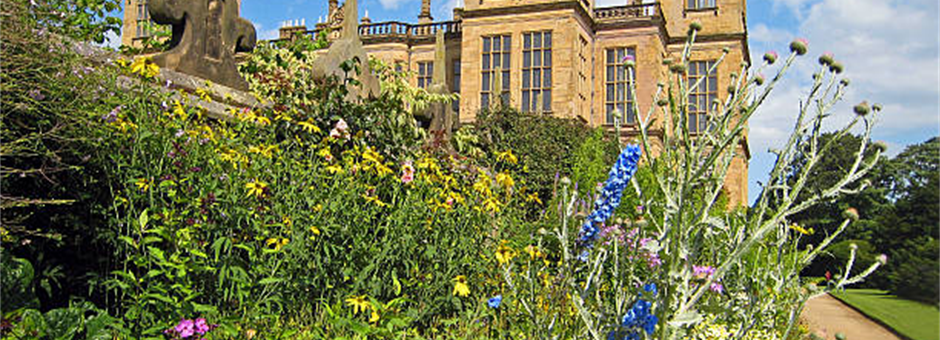
FOW Hardwick Hall
FOW Hardwick Hall
FOW Hardwick Hall
FOW Hardwick Hall
Two halls, extensive gardens and grounds, good facilities, no major traffic jams and a dry day – Friends of the Whitworth had a great day out on Thursday 4 July. Hardwick Hall is huge and its contents are spectacular. Hardwick Old Hall is a fascinating, explorable ruin, mostly not much older than Hardwick Hall and in some sense a ‘practice run’ for the later building.

Many of Hardwick’s textiles and furnishings produced and acquired for the Hall when it was built by Bess of Hardwick, Countess of Shrewsbury, in the 1590s are still there, with several of Bess’s descendants their diligent custodians over the centuries and now looked after by the National Trust.
We had many textile enthusiasts and not a few experts in our FOW visitor group. One highlight was the recently restored group of thirteen tapestries featuring the Biblical exploits of Gideon. Undergoing conservation work for the past 24 years, these massive textiles returned to the walls of the Long Gallery in 2023, alongside many of Hardwick’s noted collection of portraits of royals, nobles and officials of state.
We could also tour the Material Power exhibition, which set out not only technical information about the making of aristocratic ‘domestic’ textiles, but highlighted how powerfully patronage was incorporated into them. Beyond emblazoning ES (Elizabeth Shrewsbury) and the family heraldry (stags with collars of wild roses) at every opportunity, strong female qualities that Bess, survivor of four marriages and frequent challenges to her family’s fortunes, would likely champion are found in her furnishings. Notable are the five Virtuous Women embroidered appliqué wall-hangings that Bess commissioned and brought to Hardwick from her previous home at Chatsworth. Each hanging features a revered woman of legend flanked by a personification of virtue to either side, each figure within an arch and surrounded as a group by a European classical columnar frame.

So much to see. I am sure each of us had our own favourite encounters. I loved the inlaid wooden table in the High Great Chamber, with its scattered inset decoration of playing cards, backgammon board, stringed instruments and musical scores, as well as the inevitable coats of arms. I enjoyed climbing the 127 steps of the Old Hall, with opportunities at each floor to look at the inner fabric of walls still showing their fireplaces and narrative plaster panels, and a view of Derbyshire at the top. Hardwick Old Hall was effectively rebuilt by Bess in the 1580s immediately prior to work starting on her new hall adjacent to it. Enough remains to see her patron-hand in its surviving decorative features. I also saw the mason’s hand in the mason marks on an oven archway.

I could have explored so much more, but it was nice to chat to other Friends in the café before setting off home. There is more than enough to appreciate and enjoy to justify another visit.
Two halls, extensive gardens and grounds, good facilities, no major traffic jams and a dry day – Friends of the Whitworth had a great day out on Thursday 4 July. Hardwick Hall is huge and its contents are spectacular. Hardwick Old Hall is a fascinating, explorable ruin, mostly not much older than Hardwick Hall and in some sense a ‘practice run’ for the later building.

Many of Hardwick’s textiles and furnishings produced and acquired for the Hall when it was built by Bess of Hardwick, Countess of Shrewsbury, in the 1590s are still there, with several of Bess’s descendants their diligent custodians over the centuries and now looked after by the National Trust.
We had many textile enthusiasts and not a few experts in our FOW visitor group. One highlight was the recently restored group of thirteen tapestries featuring the Biblical exploits of Gideon. Undergoing conservation work for the past 24 years, these massive textiles returned to the walls of the Long Gallery in 2023, alongside many of Hardwick’s noted collection of portraits of royals, nobles and officials of state.
We could also tour the Material Power exhibition, which set out not only technical information about the making of aristocratic ‘domestic’ textiles, but highlighted how powerfully patronage was incorporated into them. Beyond emblazoning ES (Elizabeth Shrewsbury) and the family heraldry (stags with collars of wild roses) at every opportunity, strong female qualities that Bess, survivor of four marriages and frequent challenges to her family’s fortunes, would likely champion are found in her furnishings. Notable are the five Virtuous Women embroidered appliqué wall-hangings that Bess commissioned and brought to Hardwick from her previous home at Chatsworth. Each hanging features a revered woman of legend flanked by a personification of virtue to either side, each figure within an arch and surrounded as a group by a European classical columnar frame.

So much to see. I am sure each of us had our own favourite encounters. I loved the inlaid wooden table in the High Great Chamber, with its scattered inset decoration of playing cards, backgammon board, stringed instruments and musical scores, as well as the inevitable coats of arms. I enjoyed climbing the 127 steps of the Old Hall, with opportunities at each floor to look at the inner fabric of walls still showing their fireplaces and narrative plaster panels, and a view of Derbyshire at the top. Hardwick Old Hall was effectively rebuilt by Bess in the 1580s immediately prior to work starting on her new hall adjacent to it. Enough remains to see her patron-hand in its surviving decorative features. I also saw the mason’s hand in the mason marks on an oven archway.

I could have explored so much more, but it was nice to chat to other Friends in the café before setting off home. There is more than enough to appreciate and enjoy to justify another visit.
Comments & Discussion
No comments to display